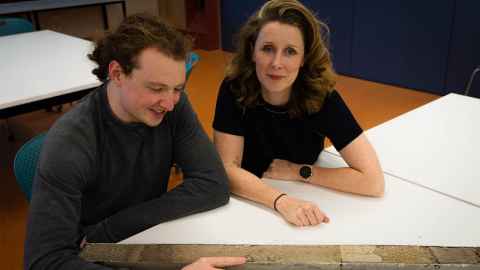Deep-sea expedition to research mega earthquakes
21 November 2025
University of Auckland scientists are part of an international team exploring the geology of the Japan Trench.

Two scientists from Waipapa Taumata Rau, University of Auckland will soon embark on an international deep-sea drilling expedition to investigate an earthquake zone off Japan.
Marine geologist Associate Professor Lorna Strachan and PhD student Anthony Shorrock will join a team of scientists from around the world on International Ocean Discovery Programme Expedition 503.
The pair will spend 19 days aboard Chikyu, one of the world’s most advanced scientific research vessels, off the coast of Japan from 24 November.
Scientists will drill into the Japan Trench seafloor – the drill pipe extending no less than 8 kilometers down – near the epicentre of the March 2011 Tōhoku earthquake which unleashed a tsunami and killed more than 18,000 people.
Two tectonic plates meet in the Japan Trench and “megathrust” earthquakes such as Tōhoku are triggered when pressure builds up and one tectonic plate is forced beneath the other.
Researchers will study the samples in the ship’s laboratory to discover more about such devastating earthquakes and how often they strike.
Ultimately, the cores will be stored at the Kochi Institute for Core Sample Research University in Japan – one of only three repositories around the world for such samples.
Scientists will drill into the Japan Trench seafloor near the epicentre of the March 2011 Tōhoku earthquake which unleashed a tsunami
“Megathrust earthquakes are the largest and most destructive on Earth,” says Strachan, who works in the School of Environment.
“They release incredible amounts of energy and can reshape coastlines in minutes. By studying the layers of sand and mud left behind, we can piece together the story of past events.”
In New Zealand, the geologist and her PhD students are researching the zone off the East Coast of the North Island where the Pacific and Australian tectonic plates meet – potentially our largest source of earthquake and tsunami hazard.
Megaquakes generate underwater landslides and sediment avalanches, which play a role in the planet’s carbon cycle.
In New Zealand, the zone off the East Coast of the North Island where tectonic plates meet is potentially our largest source of earthquake and tsunami hazard
“When these avalanches rush into deep trenches, they don’t just move sand and mud – they carry organic carbon,” she says. “Some of that organic carbon feeds deep-sea ecosystems, and some is buried for thousands of years.”
Strachan is especially interested in extracellular polymeric substances (EPS) – or what she calls “biosnot” – sticky excretions from microorganisms that can bind sediment grains together and alter how underwater flows behave.
“EPS has been largely overlooked, yet it could account for up to 40 percent of organic carbon on the sea floor,” she says. “We want to know if it’s present in these deep-sea deposits, how it affects the flow of sediments, and what part it plays in long-term carbon storage.”
A previous 2021 drilling mission in the Japan Trench reached down 40m, revealing geologic records stretching back about 10,000 years, so this mission will be going deeper (up to 150 m) and further back in time.
Australian and New Zealand scientists access state-of-the-art international drilling projects through the Australian & New Zealand International Scientific Drilling Consortium.
Media contact
Paul Panckhurst | Science media adviser
M: 022 032 8475
E: paul.panckhurst@auckland.ac.nz